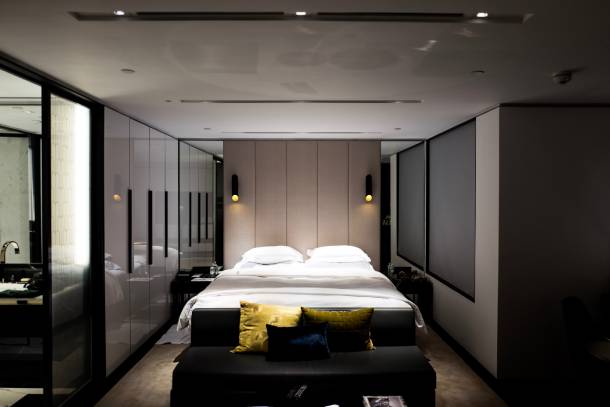So, you’ve got a house – either to live in or to rent out – but you’re (literally) in the dark about the best way to light it up. It might seem unimportant in the grand scheme of design, but the way you light where you live can be the difference between turning a ‘house’ into a ‘home’.
A well-lit home is not only of functional importance, but one of the most important decorative elements to consider. Beyond giving specific rooms the right illumination to serve its purpose, lighting can change the overall aesthetic, mood, atmosphere – and your home’s rental potential.
It’s true, in a competitive rental market lighting is one of the most simple and cost-effective ways to increase your home’s value. Getting the lighting wrong can create a negative impact on your living space, putting off tenants with dark, uninviting (sometimes creepy!) spaces.
With that image in mind, let’s go through some of the most important elements of lighting ideas for your home.
Types of lighting ideas
Depending on your needs, you’ll need to think about the best way to light a room. The 3 main types of lighting across your home are ambient, task or accent. Let’s take a look at what each one means:
1) Ambient lighting (or general lighting)
This type gives the entire room light, without a focus on a specific area. It typically gives the room a soft glow and illumination, without any harsh glare or focus.
This could be bright lighting for a bold atmosphere, or lights with a dimmer option to provide something more intimate or romantic.
Ambient lights are typically on the ceiling, and provide additional lighting in conjunction with the natural light that is already present in the space.
2) Task lighting
Used alongside your ambient lighting to provide additional illumination in specific areas for a task, such as over a desk, on a workbench or above a kitchen island.
Before deciding on task lighting, you need to consider the activity being done in the space. A desk lamp would provide task lighting in a home office, while wall-mounted adjustable arm lamps – or swing-arm lamps – could be useful in the bedroom above bedside tables for reading purposes.
These type of fixtures are also suitable for children’s areas in place of standing or floor lamps, which could be easily tipped over.
3) Accent lighting
Highlights a specific object in your home, such as a piece of art, shelving or display cabinets, which draws attention to a focal point. Accent lighting done correctly can add drama and style to your home, illuminating objects you want on display and shadowing dull areas.
Lighting ideas for 3 key rooms
1) Kitchen lighting

Just like a healthy, balanced diet, a kitchen needs just the right amount of light to help you utilise the space properly for both its functional purpose and its aesthetic.
For your ambient lighting, consider casting as much lighting as possible evenly across your ceiling to ensure a spread of light.
You don’t want any dark, moody spots in a kitchen, so kitchen lighting should be bright (but not harsh) and inviting.
Because the kitchen is where food is prepared, you also need to make sure you have the right task lighting to illuminate the top of kitchen islands or benches.
Consider pendant lights to hang from the ceiling – roughly 70-80cm apart from each other and at least 90cm above the island.
The ideal number of pendants over a kitchen island or bench is 2, but if you want to use 3, make sure they sit higher up and don’t hang too low.
For other tasks and accents, you can also consider under-cabinet lighting to lighten up shadowy areas where you might prepare food or read a recipe book.
LED strip lights can also be a good idea to brighten shelving and cabinets.
2) Bedroom lighting

The bedroom is your haven, and so it must be lit properly to make sure it’s the perfect spot to relax in, and sleep.
The first thing to consider is the size of your bedroom and the height of the ceiling – this will dictate what sort of lights to install (recessed lights are typically best for an even spread of light that doesn’t involve big pendants hanging in the way).
Then, consider the style of your bedroom to decide whether floor lamps, wall lamps or other task and accent lighting will suit you.
Wall-mounted lamps are typically a great idea to draw attention to a dramatic headboard and also provide enough light for reading and soft illumination of the room when the main lights are switched off.
PropertyGuru Tip
Consider several lights of lower wattage rather than one or two bright fixtures. This will give your bedroom a more relaxed, cosy feel.
3) Living room lighting

Living room lighting is one of the most important to think about for your home. This is the area where people congregate–- to relax, talk, eat or entertain –and with so many things to account for, you need to consider all types of lighting for it to work well.
In general, it’s a good idea to consider contemporary lighting for a living room, or warm wall lights to create a softer ambience to relax in.
If you’re positioning wall lights, make sure to install them about a head higher than the average person’s height so that people won’t be greeted by a harsh glare when standing and walking around.
Pendant lamps – particularly large, ornate ones on high ceilings – can create a statement piece for your living room while projecting ambient light across the space.
In some houses, something dramatic like a chandelier lamp might work, while for smaller houses, a simple industrial or traditional hanging light with a neutral lamp shade will do the trick.
Standing floor lamps tucked behind couches can make excellent task lighting for quiet reading nooks, too.
Other lighting ideas to consider
- Light only what you need to see: If you’re getting overwhelmed with all your lighting options, just think about what needs to be seen. Too few lights will create a dark living space, while too many can look confusing and create an overly dazzling space.
- Install dimmers everywhere: It’s the best way to change the ambience no matter what room you’re in. Brighten up the space when needed, then dim the lights to watch a movie or get cosy with your loved one.
- Lamps are a cost-effective choice: If you don’t have the budget to redesign the lighting of your entire home, consider various types of lamps to change up your spaces. From wall to floor to desk, there are hundreds of lamp options and styles to suit every home.
- Contract or DIY?: It’s really up to you, your budget, and your abilities. For any necessary rewiring and electrical work, always call in a professional. But installing simple lights available from places like IKEA can be done yourself – just be careful you don’t damage your walls or short-circuit the entire neighbourhood!
- Don’t forget outdoor lighting: If you have a front porch, a patio, a balcony or an entryway, consider the appropriate lighting for easy accessibility and safety. If you have the luxury of a garden, consider spotlights to brighten up the outdoors at night and pendant lights to illuminate outdoor seating arrangements for entertaining guests.
Now that you’re going to have one of the most well-lit homes in your area, it’s time to also think about other design aspects to create a homely space. Have a read through our design guides to consider other ways to spruce up your property.
Disclaimer: The information is provided for general information only. PropertyGuru International (Malaysia) Sdn Bhd makes no representations or warranties in relation to the information, including but not limited to any representation or warranty as to the fitness for any particular purpose of the information to the fullest extent permitted by law. While every effort has been made to ensure that the information provided in this article is accurate, reliable, and complete as of the time of writing, the information provided in this article should not be relied upon to make any financial, investment, real estate or legal decisions. Additionally, the information should not substitute advice from a trained professional who can take into account your personal facts and circumstances, and we accept no liability if you use the information to form decisions.



